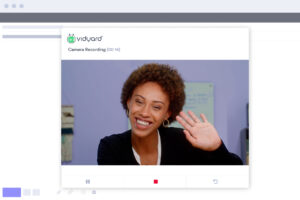 Read the essential guide to getting started with video marketing. Get the Guide
Read the essential guide to getting started with video marketing. Get the Guide 
How ApplyBoard Built a Fully Functional Video Team From Scratch
At ApplyBoard, Mathew King manages a fast-growing video team at a company that has recently made video a key priority.
Learn about the decisions Mathew made while building his video resources, how his team navigates a busy content request schedule, and his advice for video departments that are just getting off the ground.
In Vidyard’s Behind the Scenes Series, we sit down with Vidyard customers leading the charge in video marketing, video for sales, and video across the enterprise. In this episode, Content Strategy Manager Rebecca Whitaker teams up with ApplyBoard’s Mathew King to discover how he built a successful video team from the ground up.

Building a Video Team from the Ground Up
How do you build a robust video division from scratch?
That’s exactly the challenge that Mathew King, Manager of Video Production at ApplyBoard, found himself facing when he joined the company in 2020.
ApplyBoard is a Canadian business that helps connect students with educational opportunities around the world. With video’s popularity exploding in terms of content consumption, education, and influence over buying decisions, ApplyBoard’s executives realized that video would have to become a major facet of their business.
However, ApplyBoard’s video-focused employees numbered only two, with the newly hired Mathew King serving as the ranking manager. As such, it fell to him to build and nurture a top-class video team.
Quick Expansion of the Core Video Team
Mathew wasn’t the first video producer at ApplyBoard. But by the time he joined the company, he was the captain (and sole crew member) of the video ship.
“Within that time, [ApplyBoard] recognized that they wanted to bring on a manager-level to be able to bring in more process, more structure, and grow things from there,” Mathew says.
“Effectively, I started from scratch … The week before I started, I was building out job descriptions for my team so we can get hiring, we can get job postings out immediately.”
He started by filling out key areas essential to the functionality of a working video team. The team grew to three employees, then five, then seven. When it became apparent that additional layers of project management would be needed, additional associate producers were brought on to act as day-to-day product managers and scriptwriters. What began as a solo operation is now closing in on 15 employees.
Bridging the Gaps to ApplyBoard’s Other Teams
Mathew soon recognized that in order to be successful in the long term, his video squad would need to align with ApplyBoard’s graphic design and communications teams to establish a united front of creative services.
“The graphics design team, they often hold the keys to the brand—the look, the feel, the identity,” Mathew says. “I had to ensure that if we brought a team member on, that they were going to be a bridge member to them.”
This led to the acquisition of a motion graphic specialist to blend the worlds of video and graphic design. Adding this resource meant that the video team could create content that relied less on having human actors on screen, such as motion graphics, animations, and GIFs.
Being able to ‘videoify’ art assets being developed by the design team made it quicker, easier, and more resource-efficient to create video content that required less lift without sacrificing quality. This was especially valuable when the video team had limited access to the office and its equipment during COVID-19.
Similarly, to align more closely with ApplyBoard’s communications team, Mathew prioritized hiring a video producer to write scripts that reflected the voice and tone of ApplyBoard’s brand.
Mathew’s next step was to hire a social media video producer, who serves as a bridge between the video and social media teams. It’s a measure that enables the nimbler creation of timely social content.
This holistic video approach enables Mathew’s video team to work closely with the rest of the company’s marketing squads. They can create video content that blends seamlessly with the voice and values used throughout ApplyBoard’s marketing programs.
Fulfilling Other Departments’ Need for Video
As Mathew soon found, no video team is an island. Requests for video content soon started coming in from other departments across ApplyBoard.
Marketing is a substantial source of requests, requiring videos for everything from demand generation to social media to sales enablement. Mathew’s team creates videos covering everything from best practices to education and training.
These often take the form of multi-video or multi-module series that need a month or more to produce. Because of this, building a video team with enough resources to handle such large requests is a must.
“We can’t lock up one individual for a month when you’re a three-person team,” Mathew says. “It’s just kind of like, well, there goes a major one-third of our resources.”
Mathew’s team also produces internal communications videos for the human resources team. With employees scattered across the globe, company update messages often take the form of three-to-five-minute asynchronous videos that can be watched on each viewer’s schedule.

 Read the essential guide to getting started with video marketing. Get the Guide
Read the essential guide to getting started with video marketing. Get the Guide How the Team Manages Video Requests
Not all video content requests are created equal. “There’s a bit of a tier structure that we follow in terms of what we take on,” Mathew says. “Not to say that the lowest tier isn’t important. It just requires less of a keen eye on the execution of it from the video team.”
Video needs are sorted into tiers depending on how the video will be used. Take two example videos: The first video will be watched by 50 people one time, while the second video will be posted to a social channel, where it could be seen by hundreds or thousands of people a day for years. Mathew highlights that large-audience social video deserves a little more polish to ensure it’s a sparkling product.
Empowering Stakeholders to Manage Their Own Videos
Depending on workload, it can be a week or more before the video team can get started on a specific request. If a video destined for a smaller, more intimate audience has a more immediate time limit attached, it can often be managed by the requesting teams themselves.
“If they need it by next week, chances are that we might not be able to get to it,” Mathew says. “Let us give you the tools to empower you to take that on yourself to make something of quality within a quick time.
“So depending on their timelines and the cadence in which they need to create their content, we have just as much of a role in educating and empowering others within our company to be able to take on video themselves at the appropriate level.”
Mathew’s team enables other ApplyBoard employees to create their own simple, straightforward, and effective video content. They provide best practices for recording at home, as well as how to perfect framing, audio, and lighting—along with other pre-built assets like animated logos and outros.
It’s a great fit for those lower-tier watched-once-by-a-small-audience videos. It’s also relatively quick and easy to accomplish, even for non-pros, and is invaluable for building authentic relationships between the ApplyBoard employee and the viewer.
“Getting stakeholders from other departments to feel like they are just as accountable for the success of the video content has been a fantastic education piece for us,” Mathew says. “We’ve had so much adoption and so much better conversations through growing that relationship over time.”
When it comes to larger video projects, Mathew’s team may be the experts at creating the content, but the stakeholder is the knowledge expert within their field. “We need to have this collaborative experience that’s a well-oiled machine to be able to get to the end result—being your piece of video content that you’ve requested.
“So holding hands with them from start to finish is what we like to kind of do along the way. They see the effort and time that goes into it too, and then they have a better appreciation for setting their timelines and expectations accordingly.”
How ApplyBoard Measures Video Success
ApplyBoard’s investment into video has since paid off.
“We’ve put out some pretty big numbers in terms of just putting content out into the world,” Mathew says. “We have the massive land share of the online presence within the competitive landscape.”
Because ApplyBoard’s primary goal is to educate and provide resources to students and schools, Mathew holds KPIs like viewership and engagement in high regard.
“Who’s engaging with us, and where?” he says. “Where are our videos living? Who’s absorbing the content, and where are they? Is that a popular market for us, or is that kind of a blip on the radar where we didn’t realize people were watching?”
His team uses Vidyard’s advanced video analytics tools to track content’s performance and provide answers to such questions.
Mathew also solicits viewer feedback through questionnaires. They’re a powerful tool for finding out how viewers absorb content, how the quality of the video is received, and whether communication is clear enough to be understood by a diverse audience. This feedback is a valuable window into how ApplyBoard’s video content impacts the student journey.
“It’s a moving target,” Mathew says. “But it’s one that we can definitely attain over time.”
Mathew’s Advice for Video Teams Getting Started
Choose the Right Team Members
Once you’re armed with an idea of what your successful video team will look like, it’s time to acquire the right team members. “You don’t want to work in a silo, right?” says Mathew. “So you have to have people that can be effective communicators that bring complementary skills to the table beyond yourself.”
He suggests charting out where your skills, strengths, and weaknesses lie, then building a team to complement. “Then you can learn off of each other’s various skills to then bring all of your skills up together.”

 Build your brand, generate more leads, and close more deals with Vidyard. Learn More
Build your brand, generate more leads, and close more deals with Vidyard. Learn More Implement Project Management Processes
Putting processes in place to process new requests is paramount. “Otherwise, it becomes the Wild West in terms of taking on video requests, depending on how hungry the company is for video,” Mathew says.
Mathew suggests leveraging effective project management software. For his team, it’s extremely helpful for keeping projects accountable and on track.
Equally important is setting expectations and timelines that you know your team can meet. Be proactive in prioritizing the most timely and topical projects. Recognize resource shortages early and reallocate what’s at your disposal based on levels of need. If necessary items of video content are suffering from skill shortages, explore hiring to fill those shortfalls.
“At the end of the day, it makes for a better end product and less stressed people,” Mathew says. “You can’t cut somebody in two. I can’t make somebody edit two projects at one time … So planning things out appropriately is going to make for a better end product on each piece of content that we touch.”
Make Your Subjects Feel Comfortable on Camera
Who should you be putting in front of the camera in the first place?
“Look at who your shining stars are within your company,” Mathew says. “Feature them and let them speak to the company or about the company. Even though maybe it’s not always the person that you would anticipate, but they just have the appropriate energy and presence to be able to come off well on camera.”
He suggests remembering that being on camera can be stressful for your subjects. It’s key to be empathic, as well as to make them feel like they’re in control of the conversation.
Mathew recommends approaching interviews like casual barside chats. “I’m going to ask you some questions because I want to know more about you,” he says. “You’re the pro of your world; I’m not. So let’s start the conversation based off of that. So forget the lights. Forget the camera. It’s just you and me having a conversation.”
If your subject starts to pull back, don’t withdraw as well—instead, try asking a few passive questions to get back into the appropriate interview space. “Don’t try and rush the experience, because they’ll feel that,” Mathew says.

 Camera shy? Being on video can be terrifying. Get our top tips for being more comfortable on camera. Get Confident
Camera shy? Being on video can be terrifying. Get our top tips for being more comfortable on camera. Get Confident ApplyBoard connects students, schools, and recruiters to simply the process of studying abroad. Founded by three brothers in 2015, ApplyBoard has since expanded to over 1,000 employees, including Mathew King and his video team.
The company works with over 1,500 institutions and more than 7,500 recruitment partners to link students with educational opportunities around the world. Students use ApplyBoard’s platform to research schools, assess their eligibility, and submit application documentation, as well as receive guidance on key topics like applying for study visas.
ApplyBoard has achieved a #1 spot on Deloitte’s Technology Fast 50 list, and was also named its fastest-growing Canadian technology company in 2019.

